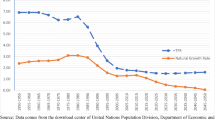Abstract
Muslims are often blamed for having higher number of children or fertility because of their religion. However, the literature shows that decline in fertility is secular process and associated with the economic development. Given that a majority of Muslims in India belong to lower class, the community as a whole has relatively higher fertility rate. As per 2011 Census of India, the Muslim population in Telangana is 4.46 million, which is expected to grow to 5.3–5.6 million by mid-2026. It is found that contrary to the popular impression, the rate of growth of Muslim population is not much different from the state average. However, the median age among Muslims in Telangana and in rest of the country is considerably lower than the State and national averages, respectively. The dependency ratio, especially the younger age groups, is found to be higher among the Muslims in the state.
Access this chapter
Tax calculation will be finalised at checkout
Purchases are for personal use only
Similar content being viewed by others
References
Basant, R. (2012). Education and Employment among Muslims in India: An Analysis of Patterns and Trends (W.P. No. 2012–09–03). Ahmedabad: Indian Institute of Management.
Census of India (2001). Religion Data for Andhra Pradesh (District/sub-district/town/village) PCA 2001 Census.
Census of India (2011). Religion Data for Andhra Pradesh (District/sub-district/town/village) PCA 2011 Census.
Guilmoto, C. Z., & Rajan, S. I. (2013). Fertility at the district level in India: Lessons from the 2011 census. Economic and Political Weekly, 48(23), 59–70.
Government of India. (2006). Social, Economic and Educational Status of the Muslim Community of India: A Report. New Delhi: Cabinet Secretariat, Government of India.
International Institute for Population Sciences (IIPS). (2016). National Family Health Survey-4, 2015–16. Telangana: State Fact Sheet.
Johnson, T. M., Grim, B. J., & Zurlo, G. A. (2015). The International Religious Demography Project. Boston University Pardee School of Global Studies, Institute on Culture, Religion and World Affairs: CURA.
Planning Department (2015). Reinventing Telangana─The First Steps. Socio-Economic outlook—2015. Government of Telangana, Hyderabad.
Rajan, I. S. (2005). District Level Fertility Estimates for Hindus and Muslims. Economic and Political Weekly, 40(5), 437–446.
Registrar General and Census Commissioner. (2004). Report and Tables on Age—Volume—1, Census of India 2001. New Delhi: Ministry of Home affairs.
Registrar General and Census Commissioner. (2011). Religious Communities by Age and Sex, India 2011—(C-15 Tables), Census of India 2011. New Delhi: Ministry of Home affairs.
Registrar General and Census Commissioner. (2011). The Number of Women and Currently Married Women by Present Age, Number of Births in the Last Year by Sex and Birth Order—(F-9 Tables), Census of India 2011. New Delhi: Ministry of Home Affairs.
Registrar General (2013). Sample Registration system. Special Bulletin on Maternal Mortality in India 2010–12. New Delhi: Ministry of Home Affairs.
Registrar General (2014). Sample Registration System Bulletin (Vol. 49, No. 1). New Delhi: Ministry of Home Affairs.
Author information
Authors and Affiliations
Corresponding author
Editor information
Editors and Affiliations
Rights and permissions
Copyright information
© 2021 The Author(s), under exclusive license to Springer Nature Singapore Pte Ltd.
About this chapter
Cite this chapter
Balasubramanian, K. (2021). Demographic Profile of Muslims. In: Sudhir, G., Bari, M.A., Khan, A.U., Shaban, A. (eds) Muslims in Telangana. Dynamics of Asian Development. Springer, Singapore. https://doi.org/10.1007/978-981-33-6530-8_3
Download citation
DOI: https://doi.org/10.1007/978-981-33-6530-8_3
Published:
Publisher Name: Springer, Singapore
Print ISBN: 978-981-33-6529-2
Online ISBN: 978-981-33-6530-8
eBook Packages: Religion and PhilosophyPhilosophy and Religion (R0)




